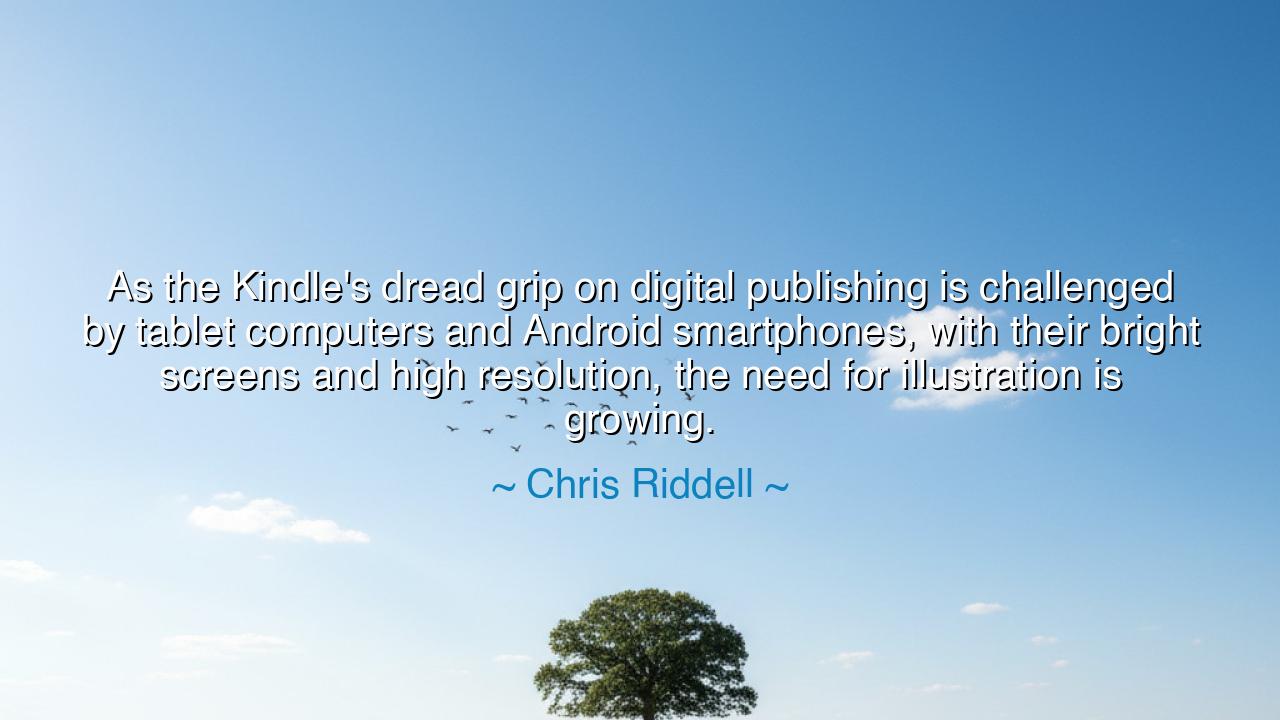
As the Kindle's dread grip on digital publishing is challenged by
As the Kindle's dread grip on digital publishing is challenged by tablet computers and Android smartphones, with their bright screens and high resolution, the need for illustration is growing.






“As the Kindle’s dread grip on digital publishing is challenged by tablet computers and Android smartphones, with their bright screens and high resolution, the need for illustration is growing.” — in this powerful reflection, Chris Riddell, the artist and author, speaks not merely of machines and markets, but of the soul of storytelling itself. Beneath his words lies a battle as old as civilization — the struggle between utility and beauty, between what is functional and what is alive. The Kindle, austere and efficient, represents the cold order of text; the tablet and smartphone, with their glowing color and infinite detail, herald the rebirth of image, of imagination made visible.
Riddell’s lament — and his hope — is born from the heart of an artist. He sees that as the world turns ever more digital, the hunger for illustration, for the visual soul of creation, returns with force. The Kindle, though wondrous in its simplicity, stripped the book to its bones: words on a gray page, devoid of texture, of light, of touch. It became the triumph of content over craft. Yet now, as new devices restore color and dimension, the artist reclaims his place beside the author. The illustrator, long exiled to children’s books and forgotten margins, rises again as the interpreter of emotion, the translator of spirit into form.
In the old days, the scribe and the artist worked as one. The illuminated manuscripts of the Middle Ages — the Book of Kells, the Lindisfarne Gospels — were not merely books; they were acts of worship. Each letter was adorned with flourishes of gold and ink, each image a bridge between heaven and the human word. In those pages, illustration was not decoration but revelation. Then came the printing press, and with it, the rise of efficiency. The picture was cast aside, sacrificed to the god of speed. Riddell’s quote is thus a kind of prophecy — that technology, which once exiled art, now becomes the very instrument of its return.
The “bright screens and high resolution” of our time are not just tools; they are the new canvases. They allow artists to paint with light instead of pigment, to create worlds that move and breathe. The same devices that once threatened the book’s beauty now offer it new forms — interactive tales, digital sketches, immersive illustrations. Riddell sees this transformation not as a loss, but as a renaissance, a time when art and text might again walk hand in hand as they did in the sacred halls of old.
His use of the phrase “dread grip” is deliberate and poetic. It evokes the fear that art may be suffocated by technology’s cold embrace — that screens may become prisons of data rather than windows of wonder. But he also speaks of challenge, of renewal. The grip loosens; the artist breathes again. In this, he mirrors the eternal rhythm of creation: every age begins with restriction, but out of that tension comes rebirth. The Kindle reduced the book to its essence; the tablet restores the spirit. Thus, progress, though it destroys, also recreates.
Consider the journey of Leonardo da Vinci, whose mind lived at the intersection of science and art. To him, invention was not separate from beauty — every diagram was a drawing, every sketch a study of truth. He saw no divide between the mathematic and the aesthetic. In the same way, Riddell urges us to reunite these forces in the modern age. Let technology serve imagination, not consume it. Let the machine amplify the hand of the artist, not replace it.
The lesson, then, is luminous: in every age of innovation, do not forget the illustrator, the storyteller of the eye. For words awaken the mind, but images stir the heart. The future will not belong to text or image alone, but to their marriage — to the creators who can speak in both light and language. Whether one writes or draws, one must remember that art is not a luxury but a necessity, for it gives meaning to invention and beauty to progress.
So, O maker of the digital dawn, remember this truth: the machine is not your master but your brush. As Chris Riddell teaches, the bright screens of our time are not the end of art, but its newest beginning. The need for illustration — for vision, for wonder, for the visual heartbeat of humanity — will never fade. For as long as words exist, the soul will demand images to see them come alive.






AAdministratorAdministrator
Welcome, honored guests. Please leave a comment, we will respond soon